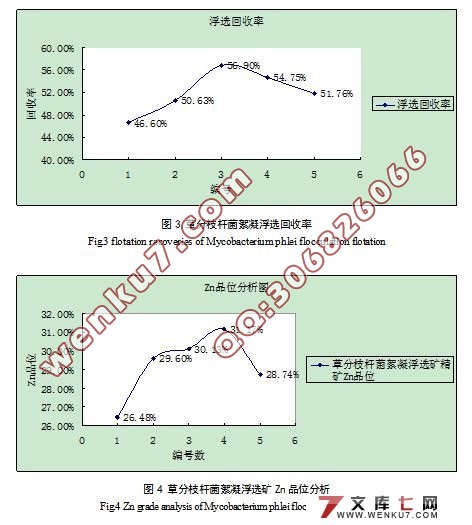草分枝杆菌诱导微细粒人造硫化矿絮凝浮选实验研究(10000字)
摘 要:利用草分枝杆菌对人造硫化矿的絮凝与吸附作用,可能改变人造硫化矿表面疏水性,提高其可浮性,从而达到分离微细粒人造硫化矿与脉石矿物并获得有价回收的目的,为从冶炼废渣中回收低品位金属资源提供一条新的途径。实验通过对草分枝杆菌的活化、富集、扩大培养得到草分枝杆菌菌液,利用草分枝杆菌细菌进行微细粒硫化矿的絮凝实验、浮选实验。实验结果表明,在絮凝沉淀过程中,添加菌液的絮凝效果显著沉降率最大能达到98.29%,但是Zn回收率提高效果不明显,仅达到21.63%。在进行微细粒硫化矿的浮选实验过程中,添加菌液有助于浮选,使Zn的品位从21.48%提高到31.17%,对于微细粒人造硫化矿中Zn的回收具有良好的效果.
关键词:草分枝杆菌;硫化矿物;絮凝沉淀;絮凝浮选
Study on flocculation flotation of micro granular artificial sulfide ore Induced by mycobacterium poleis
Abstract:Use of artificial mycobacterium phlei sulfide ore of flocculation and adsorption effect, may change the artificial sulfide ore surface hydrophobicity, improve the flotability, so as to achieve the microgranular artificial separation of sulfide ore and the gangue minerals and get a price the purpose of recovery, from smelting waste for recovery of low grade metal resources provided a new way. Through the experiment mycobacterium phlei activation, enrichment and expand from purification mycobacterium phlei bacterium fluid, using bacteria mycobacterium phlei microgranular of sulfide ore flocculation experiment, the flotation experiment. The experimental results show that the precipitation in flocculation process, add the bacterium fluid flocculation effect significantly the biggest settlement rate could reach 98.29%, but Zn recovery improve the effect is not obvious, only 21.63%. In the microgranular sulfide ore flotation tests of the process, to add bacterium fluid flotation, make the grade of Zn increased from 21.48% to 31.17%, for the microgranular artificial sulfide ore Zn in the recovery has good effect.
Key words:Mycobacterium phlei;Sulfide minerals;Flocculation sedimentation;Flocculation flotation

目 录
摘 要: 1
关键词: 1
1 前言 2
1.1 微生物选矿的现状 2
1.2 微生物作为选矿药剂应用的研究现状 2
1.2.1 微生物絮凝剂的研究现状 3
1.2.2 微生物浮选捕收剂的研究现状 3
1.2.3 微生物调整剂的研究现状 3
1.3 草分枝杆菌的国内外研究现状 3
2 研究目的和内容 4
2.1 研究目的 4
2.2 研究内容 4
3 材料与方法 4
3.1 实验原料及制备 5
3.2 实验仪器 5
3.3 微生物培养试验方法[17] 5
3.3.1 培养基的制备[18] 5
3.3.2 菌种的恢复培养 5
3.3.3 草分枝杆菌的富集培养 6
3.3.4 菌株扩大培养 6
3.3.5 草分枝杆菌的培养生长及细菌的形态特征分析 6
3.4 血球计数细菌生长数 6
3.4.1 血球计数板介绍 6
3.4.2 计数公式 7
3.5 絮凝实验方法 7
3.5.1 微生物絮凝沉淀分离实验方法 7
3.5.2 Zn含量分析方法 7
3.5.3 EDTA标准溶液配制与标定 7
3.6 微生物絮凝浮选方法 8
3.6.1 EDTA标准溶液的标定 8
4 实验结果与讨论 8
4.1 草分枝杆菌(M.phlei)的外观特征 8
4.2 草分枝杆菌( M.phlei)细菌生长数 9
4.3 人造硫化锌矿物微生物絮凝沉淀分离试验 10
4.5 人造硫化锌矿物微生物絮凝浮选试验 12
5 结论 13
参考文献 14
致 谢 15
|



